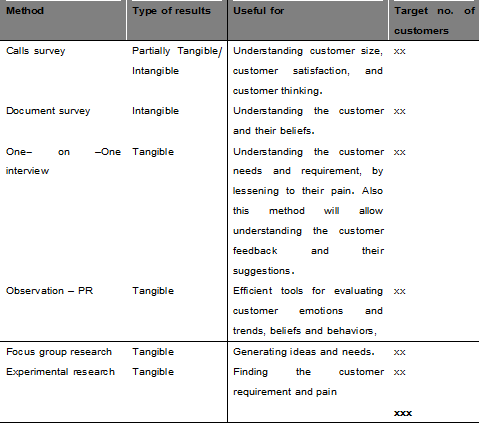Business Quotation
KUWAIT MARKET RESEARCH
Date: March 29th 2014
Customer Name: xxx
Project Number: xxx/2014
Project Subject: Kuwait Market Research
This proposal contains 8 pages –including the cover page
Project name:
Kuwait Market Research
Scope of work:
The main objective of this project is to understand Kuwait’s market, by introducing a Market Research product. The Market Research product will serve customer and their needs resolving their pain. Thus, this project is aiming to understand the customer needs and satisfy such requirement “Finding and Filling needs”. The following are the scope of work for such business;
- Calculate market size and market share
- Estimate target market and its growing rate
- Evaluate customer needs and behavior
Introduction
In order to achieve the project objectives, the following steps and guidelines will be followed;
1. Market size and Market share
The project will start with evaluating the market size in the State of Kuwait. The market size will include the total number of customer.
On the other hand, this part also will discuss the current market share, which includes the following competitors;
- Large companies
- Small companies in each City
- Individual
2. Target Market and Growing Rate
The second section of this project will discuss about the customer segmentation. Customer Segmentation is the subdivision of a market into discrete customer groups that share similar characteristics. For example the market can be divided based on Gender, Occupation, Wealth, Location, Age, etc. It is most effective when customer offerings are tailored to segments and are the most profitable and serves them with distinct competitive advantages.
In this project, the company will study and analyze the market, and then it will be distributed into one –or more- of the following segments;
- Benefits segmentation (price, service quality, .. etc)
- Population segment (ages, areas, .. etc)
- Occasion segmentation (period, reason, .. etc)
- Frequent use segmentation (high, medium, and low)
- Lifestyle segmentation (wealth, social, .. etc)
3. Customer needs and Behavior
Understand the customer’s values and human behavior, which drives buying processes. Such requirement can be converted into two parts;
- The functional needs – Tangible, such as Faster, Cheaper, Material quality, etc.
- The emotional needs – Intangible, like Personal image, Respects, Acceptable, Responsible, etc.
In addition to that, reviewing and analyzing existing customers’ feedback to ensure their retention and satisfaction.
Finally, this project will introduce two elements in the marketing field, which are
- Market research
- STP
- Segmentation
- Targeting
- Positioning – partial
Business Matrix
Methodology
The company is aiming to contact around xxx (+/- 3%) customers in the State of Kuwait– which is equivalent to ~x% of the total market, through different approaches and ways, such as;
Project duration
The time for the initial phase for this project will be around xxx days
Project Cost – Breakdown
Project benefits
The following are the expected values added to customer;
- Developing uniquely appealing products and services
- Develop marketing campaigns and pricing strategies
- Extracting maximum value from customer’s data
- Development of tailor made packages for different sections of customers
- Allocating resources to product development, marketing service and delivery programs
- Work in specialty business – Niche business
- Recommended segmentation
- Competitive advantages
- Evaluate competitors products and services
- Customer problems – Pain
- Voice and insight of customer
- Customer loyalty and Customer satisfaction index –CSI
- Ability to improve the Sales Target
- Customer persuasiveness
- Initiate marketing tactics and strategies after evaluation of SWOT
- Saving resources by improving focus
- Approach customer efficiently
- Building of business models
- Company image
Term and conditions
Contacts
P.O. Box 21407 Safat 13075 Kuwait
Sharq Ahmed Aljaber Street CBK Building Level 6

















